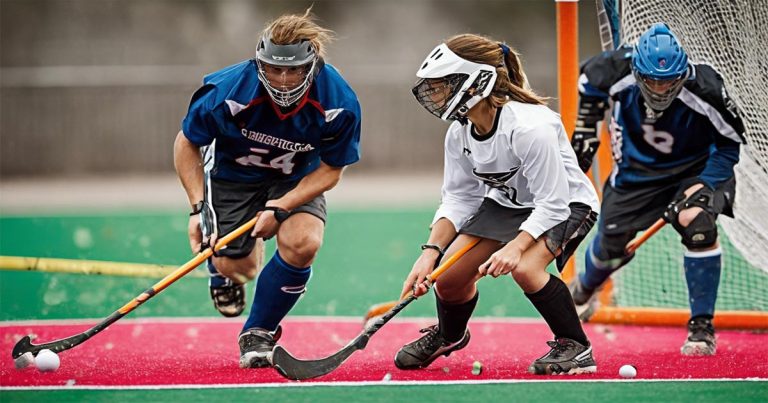Field hockey and lacrosse are two popular sports with some similarities. Yet, they have distinct differences that set them apart.
Field hockey is played on grass or turf, while lacrosse is played on grass or a synthetic field. Field hockey uses a small, hard ball and curved sticks, while lacrosse uses a rubber ball and a netted stick. Both sports require skill, speed, and teamwork.
Understanding their differences can help you choose which sport to play or watch. In this blog post, we will explore the key differences between field hockey and lacrosse, covering aspects like rules, equipment, and playing techniques. This comparison will help you appreciate each sport’s unique qualities. Stay tuned to learn more about these exciting games!

Credit: playhurling.com
Origins And History
Understanding the differences between field hockey and lacrosse starts with their origins and history. Both sports have rich backgrounds that have evolved over centuries. This section delves into where these games began and how they transformed over time.
Ancient Beginnings
Field hockey traces its roots back to ancient civilizations. Evidence suggests that similar games were played in Egypt around 4,000 years ago. Ancient Greeks and Romans also played stick-and-ball games that resemble modern field hockey. These early versions were simple and played with rudimentary equipment.
Lacrosse has a distinct origin story. Native American tribes, especially in what is now Canada and the United States, developed the game. They called it “baggataway” or “tewaraathon.” Lacrosse was not just a sport; it held spiritual and cultural significance. It was used to resolve conflicts and train warriors.
Evolution Over Time
Field hockey as we know it began to take shape in the 19th century. The modern rules were standardized in England. The first club, Blackheath, was formed in 1849. The sport grew rapidly, leading to the establishment of the International Hockey Federation in 1924.
Lacrosse also evolved significantly. European settlers learned the game from Native Americans. By the 19th century, it became popular in Canada and the United States. The first official rules were codified in 1867 by Dr. George Beers. Lacrosse became a formal sport with structured teams and standardized rules.
Equipment And Gear
When comparing field hockey and lacrosse, understanding the equipment and gear is crucial. Each sport uses unique tools, making their gameplay distinct. Let’s explore the differences in their equipment and gear under two main areas: sticks and balls, and protective gear.
Sticks And Balls
Field hockey sticks are usually made of wood, fiberglass, or carbon fiber. They have a curved end and are used to hit a small, hard ball. The ball is made of solid plastic and is about the size of a baseball.
Lacrosse sticks, on the other hand, have a netted pocket at the end. This pocket is used to catch, carry, and throw a rubber ball. The ball is slightly larger than a golf ball and softer than a field hockey ball.
| Sport | Stick | Ball |
|---|---|---|
| Field Hockey | Curved end, made of wood/fiberglass/carbon fiber | Small, hard plastic ball |
| Lacrosse | Netted pocket at the end | Rubber ball, slightly larger than a golf ball |
Protective Gear
In field hockey, players wear shin guards and mouth guards. Goalkeepers wear extensive padding, including helmets, leg guards, and chest protectors. Field players don’t need as much protection due to the nature of the game.
Lacrosse players wear more protective gear. All players wear helmets with face masks, gloves, and shoulder pads. Men’s lacrosse players also wear arm guards and rib pads. Women’s lacrosse players wear less padding but still use goggles and mouth guards.
Goalkeepers in both sports need extra protection. In lacrosse, goalies wear throat guards and chest protectors. Their gear is bulkier compared to field hockey goalies.
| Sport | Protective Gear |
|---|---|
| Field Hockey | Shin guards, mouth guards, goalkeeper padding |
| Lacrosse | Helmets, face masks, gloves, shoulder pads, arm guards, rib pads |
Understanding the differences in equipment and gear helps in appreciating each sport’s uniqueness. It also highlights the different skills required to play field hockey and lacrosse.
Field And Game Play
Field hockey and lacrosse have distinct differences in their fields and game play. Understanding these differences helps appreciate each sport’s unique aspects. In this section, we will compare the field dimensions and game duration of both sports.
Field Dimensions
Field hockey is played on a rectangular field. The dimensions are 100 yards long and 60 yards wide. The field has specific markings for different zones. These include the shooting circle and penalty spots.
Lacrosse is also played on a rectangular field. It is slightly shorter and wider, measuring 110 yards long and 60 yards wide. The field has distinct markings, like the goal area and restraining line.
| Sport | Field Length | Field Width |
|---|---|---|
| Field Hockey | 100 yards | 60 yards |
| Lacrosse | 110 yards | 60 yards |
Game Duration
Field hockey games are divided into four quarters. Each quarter lasts 15 minutes, making the total game time 60 minutes. There are short breaks between quarters and a longer halftime break.
Lacrosse games differ in duration based on the level of play. College games have four quarters, each lasting 15 minutes. High school games also have four quarters, but each quarter is 12 minutes long. This means college games are 60 minutes long, while high school games are 48 minutes long.
| Sport | Level | Quarter Duration | Total Game Time |
|---|---|---|---|
| Field Hockey | All Levels | 15 minutes | 60 minutes |
| Lacrosse | College | 15 minutes | 60 minutes |
| Lacrosse | High School | 12 minutes | 48 minutes |

Credit: www.esfexplore.org.hk
Rules And Regulations
Field Hockey and Lacrosse are both fast-paced, exciting sports. While they may seem similar, their rules and regulations differ significantly. Understanding these differences can enhance your appreciation of each sport.
Scoring Systems
The scoring systems in field hockey and lacrosse are distinct.
- Field Hockey: A goal is scored when the ball crosses the goal line between the goalposts and under the crossbar. The ball must be played within the striking circle.
- Lacrosse: A goal is scored when the ball passes the goal line, between the goalposts, and under the crossbar. Players can score from any angle or distance.
In both sports, the team with the most goals at the end wins. But the scoring techniques and opportunities vary.
Fouls And Penalties
Fouls and penalties help maintain fair play in both field hockey and lacrosse.
- Field Hockey:
- Stick Interference: A player cannot use their stick to hit or interfere with an opponent’s stick.
- Obstruction: Blocking an opponent from reaching the ball is not allowed.
- Third-Party Obstruction: Two players cannot obstruct an opponent together.
- Lacrosse:
- Slashing: Hitting an opponent with a stick in an uncontrolled manner.
- Offside: More than six players from one team in the attacking zone.
- Illegal Body Check: Hitting an opponent in the head or from behind.
Both sports impose penalties for fouls. In field hockey, a player may receive a green, yellow, or red card, indicating the severity of the foul. In lacrosse, penalties can result in time served in the penalty box.
Skills And Techniques
Understanding the skills and techniques in field hockey and lacrosse is essential. Both sports require agility, coordination, and strategic thinking. But the specifics can vary greatly between the two.
Offensive Strategies
In field hockey, players use dribbling, passing, and shooting. The game focuses on precise ball control and quick movements. Players often use the flat side of the stick to push or flick the ball to teammates.
In lacrosse, offensive play involves cradling, passing, and shooting. The use of a lacrosse stick allows for a wider range of motion. Players can pass the ball over longer distances and with greater speed.
| Field Hockey | Lacrosse |
|---|---|
| Dribbling | Cradling |
| Pushing | Passing |
| Flicking | Shooting |
Defensive Tactics
Field hockey defenses focus on blocking and intercepting passes. Players use their sticks to steal the ball or deflect shots. Body positioning is crucial to maintain control over the play.
Lacrosse defenses rely on checking and positioning. Players use their sticks to poke or slap the ball away from opponents. Defensive players must also be quick on their feet to keep up with fast attackers.
- Field Hockey: Blocking and intercepting
- Lacrosse: Checking and positioning
Both sports require strong teamwork and communication. Each player must know their role and execute it well. The differences in skills and techniques make each sport unique and exciting.

Credit: www.thelacrossezone.com
Frequently Asked Questions
What Are The Basic Rules Of Field Hockey?
Field hockey involves eleven players per team. Players use sticks to hit a small, hard ball into the opponent’s goal.
How Does Lacrosse Differ From Field Hockey?
Lacrosse uses a rubber ball and a stick with a net. Field hockey uses a small, hard ball and flat sticks.
What Equipment Is Needed For Field Hockey?
Players need sticks, a ball, shin guards, a mouthguard, and sometimes helmets. Goalkeepers wear additional protective gear.
What Equipment Is Needed For Lacrosse?
Lacrosse players need a helmet, stick, gloves, shoulder pads, and a rubber ball. Goalies have extra padding.
Are The Fields For Field Hockey And Lacrosse The Same Size?
No. Lacrosse fields are generally larger, about 110 yards long. Field hockey fields are approximately 100 yards long.
What Is The Main Objective In Field Hockey?
The main objective is to score goals by hitting the ball into the opposing team’s net using a stick.
What Is The Main Objective In Lacrosse?
In lacrosse, teams aim to score by shooting the rubber ball into the opponent’s goal using a netted stick.
How Many Players Are On A Lacrosse Team?
A lacrosse team has ten players on the field at a time. This includes three attackers, three midfielders, three defenders, and a goalie.
How Many Players Are On A Field Hockey Team?
Field hockey teams have eleven players on the field. This includes ten outfield players and one goalkeeper.
Conclusion
Both field hockey and lacrosse are exciting, dynamic sports. Each has its unique rules, equipment, and playing styles. Field hockey uses a curved stick and ball, while lacrosse relies on a netted stick and rubber ball. Field hockey is more about precise ball control and passing.
Lacrosse is faster, with more physical contact. Both sports require teamwork, strategy, and athletic skill. Whether you prefer field hockey’s precision or lacrosse’s speed, both offer great enjoyment and challenge. Understanding their differences helps you appreciate each sport better. Explore both and find your favorite!



